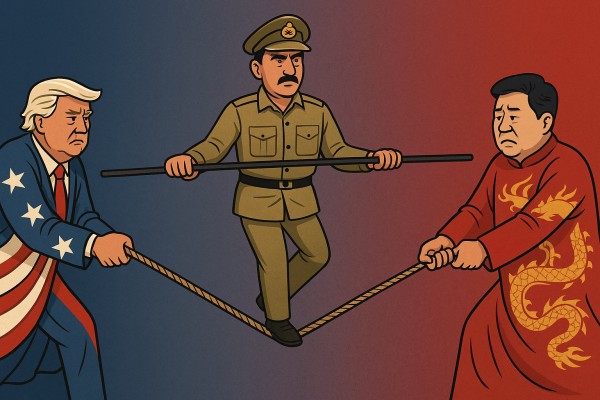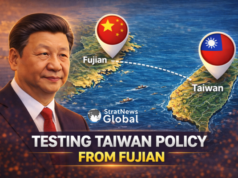In an era of escalating U.S.–China tensions, Pakistan finds itself trapped in a precarious and increasingly unsustainable balancing act.
On one hand, Beijing is deepening its economic and military footprint through the China-Pakistan Economic Corridor (CPEC) and joint arms production initiatives. On the other, Washington is reasserting itself in the region following its withdrawal from Afghanistan, determined to contain Chinese influence across Asia.
As Pakistan’s economy falters and political instability persists, Islamabad is increasingly dependent on both powers—whether to unlock IMF funds, procure weapons, or secure international legitimacy.
Both the U.S. and China are leveraging this dependence to advance their strategic objectives, turning Pakistan into a frontline state in a global contest for influence.
After years of frayed relations, Washington has begun quietly re-engaging Pakistan. The two countries’ ties soured during the Obama and Trump administrations, particularly over Pakistan’s alleged support for the Taliban and the fallout from the 2011 U.S. raid that killed Osama bin Laden. Military aid was slashed, and by the time the U.S. exited Afghanistan in 2021, Islamabad’s utility to Washington had sharply diminished.
And yet, the strategic importance of Pakistan hasn’t vanished. For the U.S., the country remains a critical vantage point from which to influence the Muslim world, monitor developments in India and China, and ensure nuclear stability—especially as concerns over Iran’s nuclear program resurface.
In Trump’s second term, some of those strategic calculations appear to have shifted. His dubious claim that he brokered the May 2025 ceasefire between India and Pakistan, dismissed outright by New Delhi, nonetheless gave Pakistan a narrative win.
Despite severe damage to key military installations, Islamabad was able to claim diplomatic success without surrendering, reinforcing General Asim Munir’s domestic standing and paving the way for his elevation to Field Marshal.
Shortly after, U.S. CENTCOM commander Gen. Michael Kurilla described Pakistan as a “phenomenal partner in counterterrorism,” and Munir was hosted by President Trump at a historic lunch during the U.S. Army’s 250th anniversary—an unprecedented meeting between a sitting U.S. president and a Pakistani military leader, unaccompanied by civilian representatives. Trump followed it up with the statement: “I love Pakistan.”
This marks a stunning reversal from Trump’s first term, when he accused Pakistan of “lies and deceit” and suspended $1.3 billion in security assistance.
Now, despite India presenting evidence of Pakistan’s continued support for terror groups, Islamabad is back in Washington’s good books—evident in the IMF’s release of a $2 billion bailout tranche on the very day the ceasefire was declared. The pivot seems less about trust in Pakistan and more about a reactive strategy to counter China’s expanding influence.
China, meanwhile, never left. When U.S. military aid dried up, Beijing stepped in with loans, infrastructure investments, and diplomatic cover.
The $62 billion CPEC—launched in 2015—has become the backbone of Sino-Pakistani ties. China funds two division-sized security forces to protect its interests in Pakistan and has exported weapons like the JF-17 fighter jet and HQ-9 missile systems while establishing joint production lines for military equipment.
Diplomatically, Beijing shields Islamabad at multilateral forums, helping Pakistan escape the FATF ‘grey list’ and supporting its claims over Kashmir at the UN Security Council—unsurprising, given that the CPEC runs through Gilgit-Baltistan in Pakistan-occupied Kashmir.
China’s interest isn’t just geopolitical. Pakistan is rich in critical minerals, particularly in Balochistan, home to the massive and underdeveloped Reko Diq copper reserves. But Chinese control over local resources—particularly Gwadar Port—has triggered unrest. Anti-China sentiment is on the rise, and Balochistan’s insurgency has intensified as locals increasingly see their province as being colonised economically.
Gwadar Port, still underdeveloped, sits at the heart of the CPEC and near the vital Strait of Hormuz, which handles nearly a quarter of global oil shipments. Though China maintains it is a commercial venture, U.S. think tanks have long warned Gwadar could be transformed into a naval outpost—granting Beijing blue-water access to the Arabian Sea.
In 2023, U.S. Ambassador Donald Blome visited Gwadar, drawing media attention and signalling that Washington is now paying close attention to Chinese investments. The ongoing Israel–Iran conflict has only underscored the region’s volatility, with fears that Iran could block the Strait of Hormuz in retaliation to Israeli strikes. Gwadar, in such a scenario, could become a chokepoint—or a battlefield.
History offers a chilling lesson: when superpowers’ interests clash in smaller, strategically located countries, political stability is often sacrificed. Syria’s former President Bashar al-Assad, once a Russian ally, was forced to step down, with interim President Ahmed al-Sharaa signalling openness to U.S. rapprochement.
In Bangladesh, the interim government under Mohammad Yunus is paralysed amid a tug-of-war between Washington and Beijing over a proposed humanitarian corridor that cuts through Myanmar’s rare-earth-rich territories.
Pakistan shows signs of a similar pattern. Former Prime Minister Imran Khan, known for his criticism of the U.S., remains jailed on multiple charges. Meanwhile, General Munir consolidates power without democratic legitimacy, benefiting from both Chinese financial backing and renewed U.S. political overtures.
Whether another regime transition materialises in Pakistan remains to be seen. But a nuclear-armed country with economic collapse looming, political institutions eroding, and armed militias operating freely is not just a regional concern—it is a global risk.
Pakistan today is not merely balancing two powers; it is being pulled in opposite directions by them. The more Washington and Beijing compete, the more Pakistan risks becoming not a partner, but a proxy. Caught between transactional diplomacy and opportunistic militarism, Islamabad may soon face the ultimate reckoning: choosing a side, or losing control altogether.
The international community must act before that choice is made for Pakistan. Proactive diplomacy, multilateral pressure, and a renewed focus on democratic legitimacy are urgently required—not just for Pakistan’s future, but for regional and global stability.





